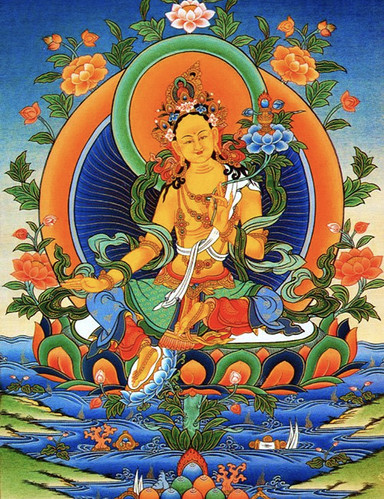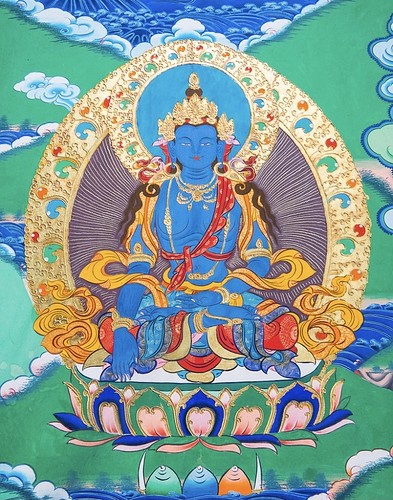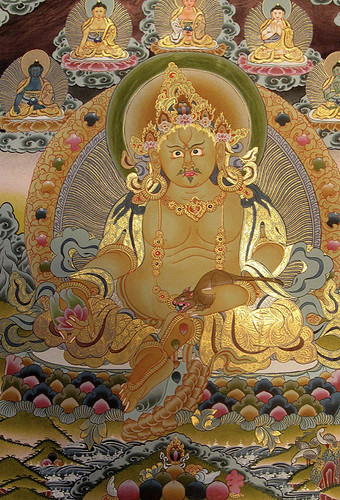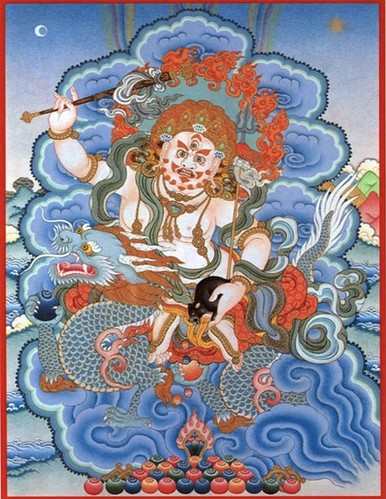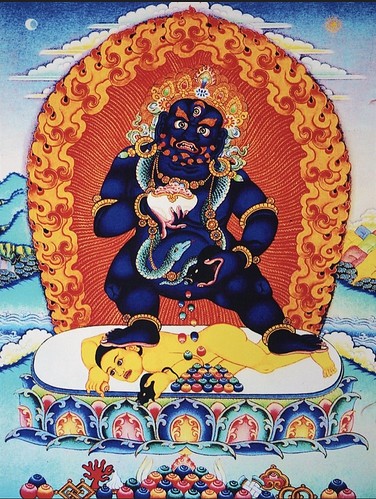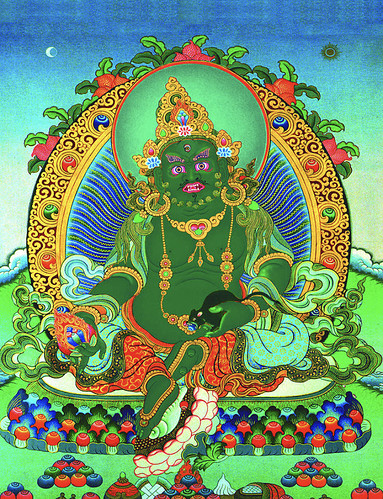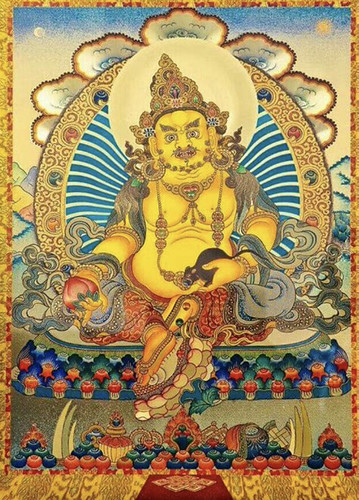Yellow Tara
Yellow Tara is yet another of Tara’s 21 manifestations and she is associated with eliminating the suffering that comes from poverty. In a more spiritual sense, she can help teach us to be more generous and kind. She instills within her devotees a deep sense of abundance which is yet another way that she can help remove the suffering of poverty. Many people become stuck in a mindset of lacking which freezes them in poverty and mediocrity. Yellow Tara can be a remedy of this. Yellow Tara can also increase your talent, reveal hidden talents, and help you be more eloquent and intelligent through the practices that are associated with her. Like all of the other Taras, any work with Her will lead you to become a better person, particularly when it comes to having a more giving and generous nature. Donation to a charity in her name would make an amazing offering for her. Other fine offerings would be ghee lamps or candles, yellow flowers, coins, and fresh water.
Mantra: OM TARE TUTTARE TURE PUSHTIM KURU SVAHA
NP I am glad to see you continue your thread. I was afraid you dissapeared, but you here so cheers! ![]()
Blue Tara, also called Ekajati, is a deity that provides her devotees and practitioners with radical protection as well as radical personal change. She is a deity that is associated with the transformation of anger into peace. Blue Tara can easily clear obstacles from both your spiritual growth and from good fortune. When you chant her mantra or perform her sadhanas, she swiftly removes obstacles to your desires/growth. Blue Tara is an excellent deity to appeal to or work with to help one deal with their own anger issues or the anger in another. Ekajati has another prominent role in Tibetan Buddhism as the protector of the ancient Dzogchen teachings and also as an embodiment of ancient primordial energy. In her more wrathful manifestations she is closely associated with both Padmasambhava/Guru Rinpoche and the dakinis as well. There are prominent stories of Tantric practitioners having visions of and being instructed by the Blue Tara. Within Tibetan Buddhism, Ekajati is said to be one of the most powerful tantric goddesses.
Her Most Basic Mantra: OM BHIM TARE VRIM
This thread is so great I started working with Kurukulle and saw my life improve drastically. Do you have any guides for sadhanas, because I dont really find a lot of information about that…
Did I understand it right that you do for example 10.000 OM BHIM TARE VRIM and then move on to the next mantra or do you chant it 10.000 x 108 times?
Thanks for posting this information
Jambhala/Dzambhala is another Buddhist deity that has several different colored manifestations. He is sometimes said to be a manifestation of Chenrezig and other times a manifestation of the Buddha Ratnasambhava. It isn’t uncommon to also hear of Jambhala being equated with Kubera, a Hindu deity of wealth. In Tibetan Buddhism, Jambhala is said to be a wealth deity and he can help those who suffer from poverty. He is also a very fierce protector and remover of spiritual and physical obstacles. There are several different stories regarding his origin, but a chief one involves him either assisting Shakyamuni Buddha and being given nectar as a gift by the Buddha, or with Jambhala being a manifestation of Chenreziig whose aim is to eliminate the suffering rooted in economic poverty. Jambhala manifests in White, Red, Green, Yellow, and Black forms. A very popular practice is to offer to Jambhala by pouring cool water over a statue of him which is said to mimic the Buddha’s gift of the nectar to him.
I’m so glad that you like this thread! And I was able to find a Kurukulla sadhana online that I could try DMing you!
I usually like to work with mantras, in the context of trying to achieve external change, by first reaching siddhi which I’ve found to usually be around 10,000 recitations and then doing 108 or more recitations at a time for an individual goal or wish.
That would be incredibly helpful, I found one pdf version but was not sure if it is the real deal…
I worked with Kurukulle on self love and enchanting my own heart and I have to say that it worked wonders!
Just like with Tara, Jambhala/Dzambhala manifests in different colors, including White Jambhala. In his white manifestation, Jambhala is said to have been born from the right eye of Avalokiteshvara. White Jambhala is an embodiment of the generosity of all Buddhas and can heal one of illnesses, bring in good fortune, stop bad omens from taking place, and purify one of malignant attachments. He is associated also with the Yellow and White Taras. When working with the White Jambhala to bring in wealth and abundance, the practice is especially effective when the intention is to use the wealth generated to help other people or animals. It is said that placing his statue near the entrance to a home or in the family room of a home will bring good fortune and monetary abundance. Just as with all of the Jambhalas, pouring water over the head of the statue will help bring in money and it is even more effective to place the statue under a fountain or water fall to continuously draw in wealth. On a final note, White Jambhala can rid one of negative karma.
Mantra: OM PADMA KRODHA ARYA JAMBHALA HRIDAYA HUM PHAT
I had interesting expirience with Ganesha and Dzhambala. I have special feelings toward Ganesha for years. I was even gifted Ganesha statue by my friend who visited India even though I asked hip about Kali that time. I do not work with Ganesha on regular basis but when I work with him it is ok. I love him in his childly playful mode, but the expirience I got once was his pissed off side 
And the story goes like this, at one point I started to explore more about tibhetan spirits, from buddist and non-buddist folklore. And I was watching thankas of Dzhambala and there was several where Dzhambala step upon Ganesha who threw up gems. For curiosity I meditated with this form and chanted mantra of Dzambala. And I forgot about that. Few days later I was visiting my astral garden (i used that time such version of astral temple) to contact with Maitre and Papa Nibbho (from gnostic vodun current) and during my meeting, suddenly, Ganesha has appeard, very angry, he threw handful of gems at me and he said this is only one warning, and I must choose if I wanted to work with him or with Dzhambala. I immediately recalled my practice from before and was suprised and a bit ashamed. I choosed Ganesha and apologised him after
Also It assured me more in what my witchy friend told me that time, that buddist entities are bossy and dominating toward other spirits and not to fuck with them if you don’t want join theirs current. For that reason I work now only with taras and some other beings from time to time but I explore ‘buddist’ current only through GV and I always check the backstory of beings first, to know wether they were colonised by lamas or they spontainously emerged.
In my experience, Tibetan Buddhist deities are very open and willing to help all who approach them and want to help you A.) Become a better person and B.) Relieve yourself from suffering. While it’s true that some Buddhist deities may be domineering to other spirits or entities, I’m sure that this isn’t always the case.
Interesting that you mention Ganesha, because in Tibetan Buddhism he is very commonly worshipped and to many Buddhists he manifests as Red Dzambhala. I’ve seen those thangkas that you mentioned though and will have to do more research on the meaning behind them.
Black Dzambhala is a wealth deity within Tibetan Buddhism. It is said that if one properly worships the Yellow and Black Dzambhalas, he or she will become wealthy and will have money flow in easily and quickly. He is the manifestation of Amogasiddhi Buddha who was asked by Shakyamuni Buddha to help relieve the suffering of those plagued by poverty. To many devotees, he is also a form of Kubera, a Hindu deity of wealth. Black Dzambhala can enable the success of all monetary or financial endeavors, purify bad luck and obstacles, help to relieve debts, and prevent loss of money or property. Many who seek protection from negative entities come to Black Dzambhala in hope of being granted his protection. On the more spiritual side of things, Black Dzambhala can help one overcome greed and tame the ego. When offering him water, pour the water on his stomach instead of his head.
Mantra: OM JAMBHALA JALENDRAYE BASHU DHARINI SVAHA
Green Dzambhala is very similar to both the other Dzambhalas and also to Green Tara. He swore a vow that he would come and protect anyone who chanted his mantra. Just like Green Tara, his green coloring symbolizes swift action and in this case, a swift desire to protect and help. He can help one ensure success and victory in many different matters, both financial and non financial. His consort is Yellow Tara and the two can often be seen in sexual union when painted on Thangkas or Mandalas. Green Dzambhala can help one to overcome envy, jealousy, and resentment.
Mantra: OM KARMA JAMBHALA AH SVAHA
Yellow Dzambhala is easily the most well known and commonly worshipped of the five Dzambhala wealth deities. According to Buddhist lore, he is either a manifestation of Avalokiteshvara or of the Buddha Ratnasambhava. Yellow Dzambhala is said to be the most powerful of the five Dzambhalas in bringing wealth to the practitioner. He is very skilled in bringing wealth to those that approach him and can be petitioned to bring wealth and abundance to those who chant his mantra. It is even more efficacious to petition him when you are petitioning him for unselfish reasons. In a more spiritual sense, he can grant you intelligence and help to eliminate greed. When offering water to him, the water is poured over the head of his statue.
Mantra: OM JAMBHALA JALENDRAYE SVAHA
